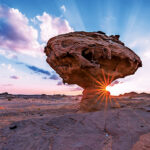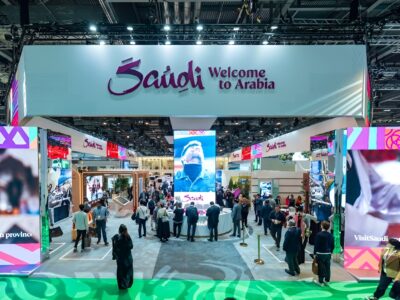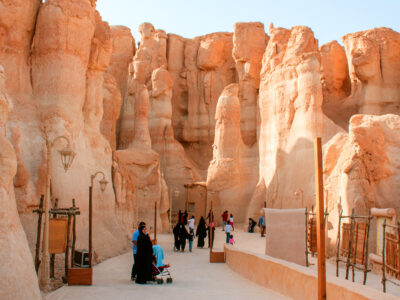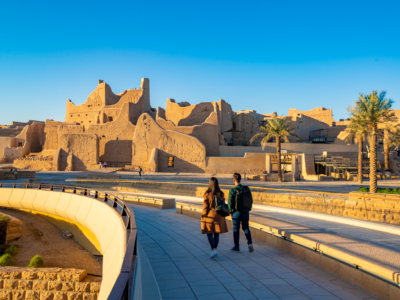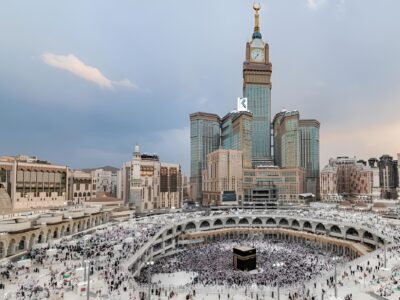
Heritage is one of the strongest assets of Saudi Arabian Tourism
A key centre on a prehistoric trade route in the Middle East has been one of the biggest mysteries of our times. It is now the site of an ambitious, multi-billiondollar project to allow visitors to plunge in history and culture.
Welcome to Al Ula, a destination that allows time travel in both directions, letting visitors decide if they wish to explore the pre-historic sites generously sprinkled around this region, about 700 km north of the port city of Jeddah. Alternatively, they could also visit the area to see the future of tourism, notably in the Middle East, as it would look in a few years from now.
Indeed, not just Al Ula, but the entire country has been undergoing vigorous transformation ever since the Crown Prince and de-facto ruler of the Kingdom, Mohammed bin Salman unveiled his ambitious Vision 2030 that seeks to change Saudi Arabia beyond recognition with vast reforms in economic, cultural and political aspects of everyday life. One of the key aims of Vision 2030 is to develop Saudi economy in a way to wean the oil-rich nation off the addiction to oil revenues and diversify the economy through development of various sectors.
And tourism is one of the key aspects of the sectors identified by the Crown Prince, popularly known by his initials MBS. To show his seriousness, MBS has set a budget of USD 1 trillion to be invested in developing all forms of tourism in the country. That is perhaps the highest spending planned by any country in the tourism sector and it is equivalent to about 40 pc of the current Indian GDP.
Indeed, many industry-watchers observe that not only has MBS put a generous budget for tourism development, but also that he has put two other ingredients key for success – vision and a team capable of executing the vision.
At the helm of implementing his Vision 2030 in tourism is former Secretary of Tourism of Mexico Gloria Guevara, who has been given a free hand to recruit her team and to manage the implementation of the plan.
The Vision 2030 is ambitious in all aspects, at least as far as tourism is concerned. Its key targets include attracting 100 million annual visits by 2030, taking contribution of tourism to 10 pc of Saudi GDP besides generating at least a million new jobs in tourism and allied sectors in the country.
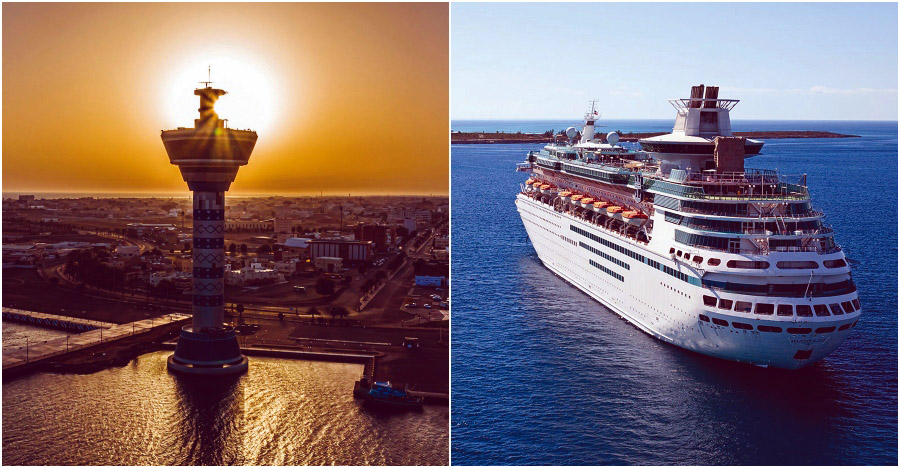
Saudi Arabia is targetting Cruise tourism in a big way
Marquee Projects
To meet the goals, equally eye-catching numbers have been set in terms of creating tourism infrastructure. For instance, it foresees setting up 500,000 new hotel rooms, six gigantesque projects like Al Ula, Diriyah Gate, a USD 50 billion project on outskirts of Riyadh with museums, retail, outdoor attractions and over 100 restaurants. It also includes the Red Sea Development Project, an eco-focused luxury site comprising 22 islands and plans for 50 hotels and an international airport. The Vision 2030 also foresees creation of Qiddiya, a USD 8 billion city for entertainment, sports and the arts, Amaala, an ultraluxury wellness resort area along the northwestern Red Sea coast and NEOM, which involves setting up an ultramodern self-contained metropolis.
Of the 500,000 new hotel rooms, most of the growth would come from the ultramega projects. For instance, Diriyah will see erection of 38 hotels, in the traditional Saudi Najdi architectural style. Of the brands that have committed to being there at Diriyah is the Indian luxury hotel firm, The Oberoi. Other names are equally global — Six Senses, Ritz-Carlton, Rosewood Hotels and Resorts, Park Hyatt, Baccarat Hotels and Resorts and Orient Express. Diriyah will also see the first LXR brand from Hiltonto open in Saudi Arabia. Incidentally, Hilton has promised to significantly ramp up its presence in the Kingdom, from the current 15 to 75 properties.
Cruise Saudi
Taking advantage of the big coastline that Saudi Arabia has with the Red Sea and the Persian Gulf, promoting Saudi Arabia as a cruise destination is another objective of Vision 2030. For this, a dedicated government-run body, Cruise Saudi, has been created which is driving, an ambitious and muscular plan to develop or modernise several ports, destinations and excursions to launch cruise tourism from ports in the Red Sea and Persian Gulf.
Cruise Saudi was launched a couple of years ago by Saudi Arabia’s Public Investment Fund to develop the country’s cruise industry in line with Vision 2030. In under a year, cruise traffic in the country jumped five-fold from 4,000 in 2020 to more than 20,000 by November 2021. The company wants to continue to grow at this mind-boggling pace and has set the target of a million cruise passengers every year by 2028, banking on the varied destinations and the ample resources.
Currently, Cruise Saudi operates cruise ports in Jeddah, Yanbu and Dammam and in three years, it plans to add ports in Duba in Neom and Jizan in the south. It says it has a catchment area with over 250 million potential customers living within a short-haul flight, of about three hours, in Asia, Europe and Africa. It says that its network of ports along the Red Sea and the Arabian Gulf will provide an ideal base for cruise passengers to discover the authentic treasures of Arabia and beyond. Banking on the growth that it has forecast, Cruise Saudi hopes to create 50,000 jobs in the cruise industry in the country by 2035.
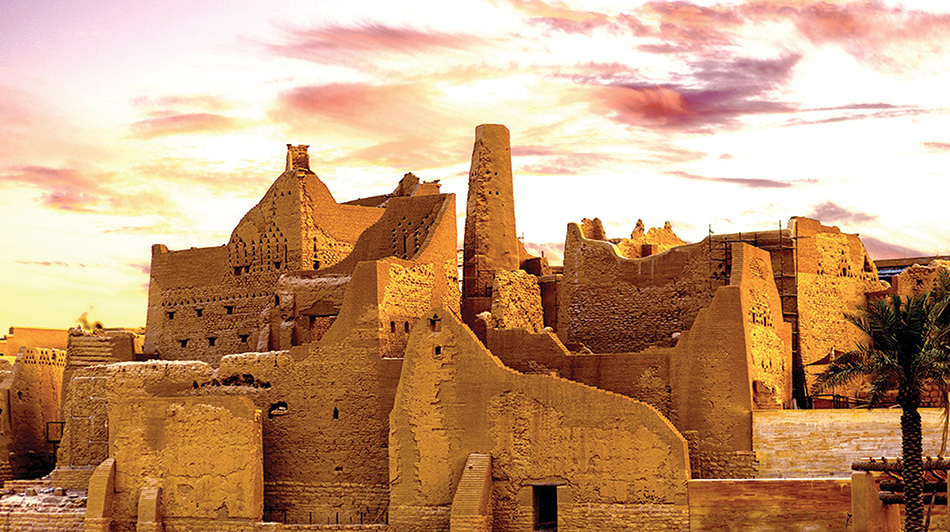
UNESCO World Heritage Site, Turaif
Al Ula: Gateway to Saudi Heritage
Little known to the outside world, the deserts of Saudi Arabia have been cradles of human civilisation in their own right. Over the past few years, several sites have been discovered or brought on the global map as being extremely rich in heritage. Prime among them, though not the only one, is Al Ula region.
Hardly any place in today’s world has remained mysterious to archaeologists and scientists, armed with the latest, hi-tech tools that enable them to visualise and recreate the world as it may have been thousands, indeed millions, of years earlier.
Yet, Al Ula, flush with oases and lush-green valleys, located on an important route with links to Damascus, Europe, Asia, Africa and the Arabian peninsula, had continued to remain hidden behind a veil of mystery even as teams of archaeologists and scientists tried to pry open the mysteries of this diverse region to understand its origins and history.
Lying on the route that connected Aden in the south to Damascus in the north, and from there onwards to Europe, Al Ula is believed to have been on the crossroads of several civilisations and multiple cultures. It was an important resting place on the trade route, with its abundant water, feeding several oases and lush green farms. Since the advent of Islam, it has also been an important site on the route connecting most of northern Middle East and Africa with Mecca and Medina, the two of the holiest sites of Islam.
For the past few years, a dedicated team of French and Saudi archaeologists, historians and researchers, assisted by a host of experts from around the world, has been trying to rebuild the story of Al Ula since the prehistoric times right up to today. Laila Nehmé, a French historian and archaeologist, has been involved in uncovering the mysteries of Al Ula for nearly 30 years now. She and her colleagues have been able to fill in many holes in the timeline of AlUla and reconstruct, using a clutch of modern tools and computer software, to present a fairly comprehensive story of Al Ula, a site that appears to have been continuously inhabited by humans for over 200,000 years.

Al Ula is a promising destination for heritage tourism
A few years ago, the story Al Ula was told in an impressive exhibition organised in Paris by the Royal Commission of Al Ula, in collaboration with the French culture ministry and the Institut de Monde Arabe (Institute of the Arab World) in Paris. The exhibition showcased all aspects of Al Ula and its evolution in the past 200,000 years, including 7,000 years of human inhabitation.
Covering over 30,000 sqkm, an area equivalent to that of modern-day Belgium, Al Ula has seen several transformations in its geological as well as zoological composition. At the exhibition, an impressive 3-D model of the region, illuminated by computer software, was set up, recreating the geological and natural evolution of the region, with a range of diverse incidents such as large-scale floods, immense volcanic eruptions and of course the seemingly endless desertification.
All of these incidents have had a huge impact on Al Ula’s history “Al Ula is literally a living museum, with its extremely well-preserved tombs, historic dwellings, monuments as well as captivating sandstone outcrops that hide in their hearts a largely untold story of over 200,000 years of history. And despite the 30-years put in by me and dozens of other researchers, Al Ula seems to be preciously guarding its secrets,” says Nehmé, adding that it was very difficult to predict with any degree of certainty the human dimensions of Al Ula, especially the variations in its population over the several cycles of ups and downs that the region clearly has seen over the course of its long history. ‘‘I would say it is difficult to put a finger on the exact figure of what might have been the maximum or even the optimum population of AlUla at a given time, notably in the early years of Dadanite and other preRoman eras. I might venture to say between 5,000 to 20,000, but it is only a guess and not based on any scientific certitude,’’ Nehmé told India Outbound.
Al Ula was also capital of the ancient kingdoms of Dadan and Lihyan, which controlled the caravan trade. The site of Hegra, modern Mada’in Salih, was the principal southern city of the Nabataean Kingdom, famed for its spectacular monumental tombs. Today, another big mystery about Al Ula is the transition between various kingdoms and empires. In the span of less than 800 years, from the 6th century BC to 2 century AD, Al Ula changed hands between the neolithic empires of Dadanites and Lihyanites and then onto the Nabateans from the Jordan valley and finally the Romans in the 2nd or 3rd century AD. Despite the frequent changes, Nehmé says the team of archaeologists has not been able to pinpoint the exact nature of these political changes.
‘‘We have not found any significant elements that can allow us to conclude that there may have been wars between the kingdoms, nor do we have any particular catastrophic moment that may have led to the change of power in Al Ula. For instance, if we had found traces of large-scale burnings or destruction at a particular time in history, we may have looked at possibilities like outbreaks of wars or diseases or even natural catastrophes. But here, so far, we have not yet found any such elements,’’ says Nehmé.
For Amr Saleh Almadani, the Chief Executive Officer, of the Royal Commission of Al Ula, these unresolved mysteries can only add to the allure of Al Ula for not just scientists and researchers from all across the world, but indeed tourists and those interested in learning about human civilisation and its evolution as well as people that like nature and environment. ‘‘Al Ula has everything for anyone looking for any of these elements. It is a jewel of Saudi Arabia and we want to share this with the entire world and that is why we are mounting a series of events and activities to allow visitors from all over the world to come and enjoy at AlUla and relive the story of the evolution of human civilisation,’’ says Almadani.
Amongst the several wonderful sights that await visitors in AlUla are thousands of rock inscriptions dating back to prehistoric period and some of which also go on to show the evolution of the Arabic script as the Nabatean script slowly evolved into Arabic in the early centuries of the first millennium after Christ. AlUla has also hundreds of tombs built by Nabateans in the same style as in their most famous city, Petra, in Jordan. The most famous Nabatean site in Al Ula is of course Hegra, recognised by UNESCO as the first World Heritage site in Saudi Arabia.
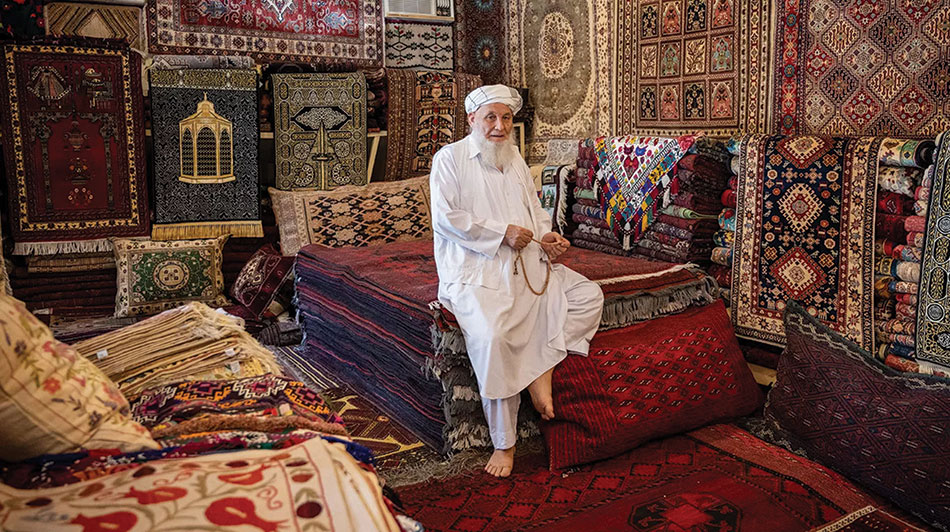
Saudi carpets are also worth a look at
Al Ula is a repository not just of the beauty of human creations. There are plenty of nature’s wonders, too, for the visitors to admire. There are hundreds of sandstone and basalt rock outcrops, carved beautifully by nature over thousands of years that offer a breathtaking view. Almadani says that the RUC has planned a series of activities to allow visitors and tourists to relish Al Ula’s wondrous creations and activities.
While opening the site to the world, Almadani also stresses that the RUC will keep the focus on community involvement and sustainable tourism to ensure that not only the heritage of Al Ula is well-preserved, but that the local community remains a major stakeholder and beneficiary of tourism and other cultural activities that would take place regularly there. ‘‘We need to be sure that we hand over Al Ula to the future generations in the same unspoilt and well-preserved state in which we have inherited it,’’ says Almadani.
Fast forward to future
Not content with only promoting the past, Vision 2030 also has some highly futuristic ideas and designs, notably Neom and King Abdullah Economic City. Sprawling in an area of over 26,500 sq km and with an estimated budget of USD 500 billion, Neom is the pet project of MBS and it envisages a whole host of post-modern services and lifestyle, with emphasis on modern industry, education, tourism, all with environmentally-sound practices. Neom is literally a bottoms-up approach as it is a modern human cluster being created from scratch on the Red Sea coast, in the north-western fringe of Saudi Arabia.
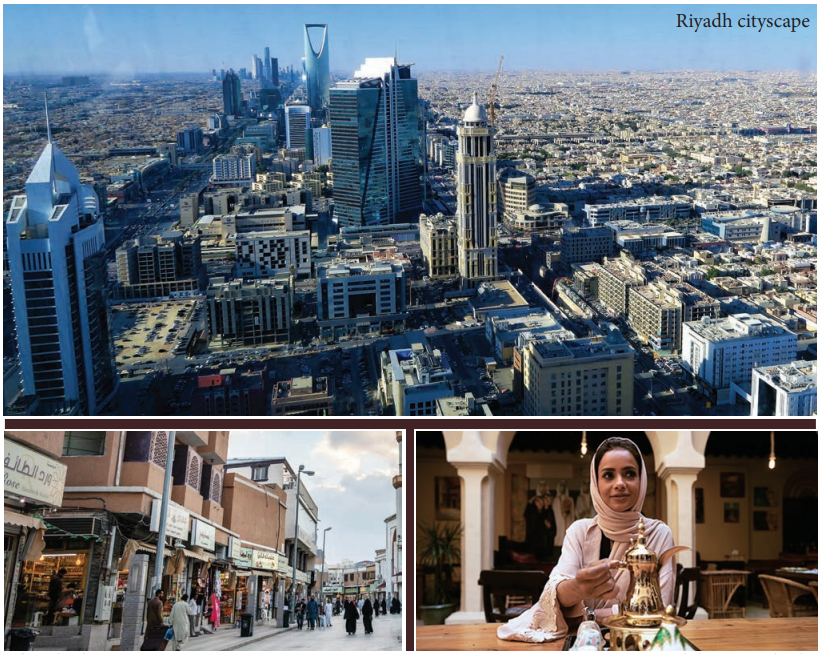
Taif Central Market (L); Tea is a popular beverage in Saudi Arabia (R)
Neom is also the world’s first independent special zone that stretches into three countries. Conceptualised as a leading global hub that exemplifies the future of human civilisation by offering its inhabitants an idyllic lifestyle combined with exceptional economic prospects, Neom seeks to attract top talent from around the world to push the boundaries of innovation.
It will have numerous destinations within, with a variety of experiences for all kinds of tourists, ranging from exotic beaches and ports with some of the best cruise options to pre-historic sites in the midst of the desert. Its landscape is also varied as the altitude shoots up from sea level at Yuba to over 2500 m at Jabal Al Lawz mountain.
With numerous ambitious and almost unprecedented developments taking place simultaneously, it is certain that Saudi Arabia will soon be a strong tourism player to reckon with, not just in the GCC, but across the world. It may oblise its neighbours to either up their game or perhaps, for lack of any option, join hands with the Kingdom to launch joint itineraries for tourists seeking to experience diverse aspects of the GCC. The latter, by far, looks to be a safer and better bet for the current heavyweights, as they try to measure up to Saudi Arabia.








